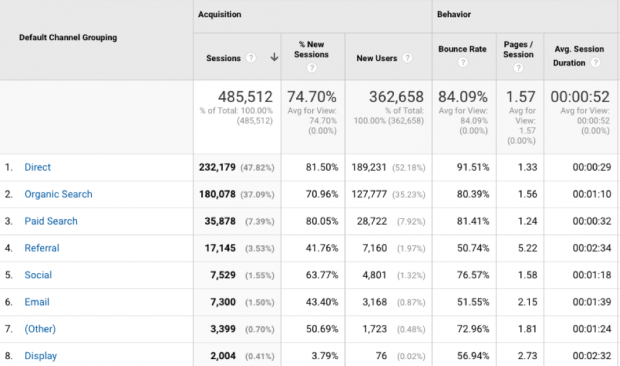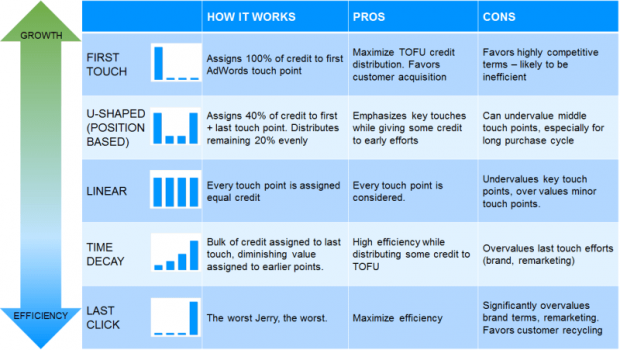When two people fall in love with a deep understanding and appreciation for one another we say things like “they’re a match,” “they fit together,” and “they finish each other’s sentences.” This is the type of relationship that businesses should strive to build with their customer and customer segments. Getting to know each other is key to building this fit in any relationship. Through analytics, attribution modeling and audience targeting in-house brands and agency teams can create a love potion for business success.
Getting to Know Each Other Analytically
Understanding your audience is everything in marketing. Without this understanding how can marketers know what to say? How can they predict the type of content, touchpoints or campaigns that will drive desirable customer behavior and necessary business outcomes? They can’t.
In order for businesses to understand their audience they should first turn to data. Google Analytics (GA) provides high level customer demographic insights as well as granular customer attribution. As marketers, we’d be lost and in the dark without it. However, new businesses and businesses that are new to GA don’t have data, so they have to collect some to take advantage of what it can do.
At a high level, GA can show you where your customers are located, so you can localize content as needed and know where to target campaigns. It can also tell you the age, gender, device type and more demographic insights that are key to developing your audience understanding.
One of the best features to understand customer behavior in GA is the acquisition menu. It can tell you where your customers came from before landing on your website. Was it from a search in Google? Was it through social media? Knowing this will allow you to better communicate through each of your marketing channels and even invest (or invest more!) in those that are driving the most traffic to your website.
Google Analytics can also help you to understand what your customers do once they’re on your site. For example, do they all go straight to your blog to read valuable information or are they navigating to the product or service pages, showing purchase intent? If Google Analytics tells you that a ton of your site traffic is going to your blog, you can drill down further to understand which blog posts interested your audience most and write more of that type of content! Companies can also see what their audience is searching for on their website through the in-site search feature to get a better understanding of what their audience is interested in from their business. Businesses should make use of as many insights and analytics platforms that are available to them to develop their audience understanding as much as possible; however, few will come close to GA.
Attribution: Show Love Where It’s Deserved
Google Analytics provides rich audience insights through its different menu options, but it is also a powerful tool for modeling and attributing value to available marketing channels. Attribution models allow marketers to understand in the most comprehensive way which actions they took that drove a customer’s behavior or interaction with your brand (or client).
Similar to data stemming from Google Analytics, businesses need to already have customers in order to collect data about customer attribution or to build an attribution model around PPC campaigns in AdWords. If you’re trying to understand how your audience behaves around PPC campaigns in Google there are a few different models that you can choose from, says Aaron Levy from Elite SEM on Search Engine Land.
Aaron cautions against first touch and last click attribution models because they just don’t offer adequate information about what’s going on inside the customer journey or your marketing funnel. Instead, Aaron suggests that U-Shaped, Linear and Time Decay attribution models work better and offer a balance between goals of growth and efficiency.
Acquisio Co-Founder Marc Poirier said 2018 will be the year of attribution modeling in his 2018 digital predictions. Knowing that marketers struggle to understand how channels like display and SEO contribute to their bottom line, he believes attribution has been a real problem that is about to change with emerging technology. “It’s going to be a matter of applying the data science and leveraging AI to properly understand it and get to the bottom of our own marketing story,” says Marc. Julie Lyle, Chief Revenue Officer at Demand Jump agrees. In an interview with eMarketer she said:
“To acquire customers, marketers have to understand attribution, and artificial intelligence can fill a lot of the gaps in existing attribution models. AI can unwind the path to purchase, and pinpoint when a customer comes to a brand’s site and leaves without converting. Maybe they looked at a particular blog post about a product, searched for that product, found it, but still didn’t convert. Why? Because they went on their mobile phone on the way home, found a coupon on an affiliate site and then converted. AI can sequence that path to purchase and explain all that.”
We agree that AI and machine learning technology is going to fast track solutions to the attribution problem and beyond, allowing businesses to understand customers better than ever before.
Personalized Love and Attention
Through GA, attribution modeling and even advanced AI technology, businesses can better understand who their audience is, what they want and even how many touch points their audience needs to become a customer. With an understanding of what turns a customer on and what keeps them up at night, marketers can build campaigns that speak directly to customers in ways that will get them to listen.
There are many different types of marketing campaigns and channels however, and each can offer different types and forms of personalized customer experiences. In PPC for example, marketers can create dynamic campaigns and use ad modifiers that allow advertisers to make customized ads based on user search queries for example. Aaron Levy said in his 2018 Digital Predictions that new “if-or-if-not” modifiers now inside Google and Bing will allow advertisers to greater customize and personalize PPC campaigns with audiences.
Target Your Audience Like Cupid
Marketers can personalize email marketing campaigns, social media marketing campaigns and even build custom audience lists and target them with the business messages that match them most. Almost every aspect of the customer experience can be personalized, but there is only so much marketers can execute and keep track of. The goal isn’t hyper fragmented data – instead marketers should seek to create measurable 1:1 marketing experiences.
Audience targeting is the main method in which marketers can deliver personalized experiences based on their understanding of customer segments. Showing that you care with customization techniques in each marketing channel is a good way to show your customer how much you care.
PPC Targeting
While there is overlap in audience targeting between channels and some work together, PPC targeting is unique. In paid search campaigns advertisers use keywords as the primary means to target users and attract clicks from searchers. Melissa Mackey believes 2018 will be the year that advertisers put audiences before keywords when it comes to targeting. She says “Keywords aren’t going away … But advertisers will get smarter about where keyword targeting fits in the marketing mix. They’ll be setting up remarketing audiences and RLSA campaigns focused on driving users through the funnel. We’re getting closer and closer to 1 to 1 marketing in paid search and social. It’s going to be exciting.”
Audience targeting is on everyone’s mind. David Szetela, FMB Media Owner and CEO, says that Bing is also advancing targeting capabilities for advertisers:
“Another area where Bing Ads will mature is targetable audiences. Savvy advertisers will get tools to let them hyper-target ads to appear mainly to their target audience with the equivalent of AdWords’ Customer Match (the ability to upload first-party data like email lists), In-market Audiences (people who have been determined to be on the verge of taking a converting action like making a purchase) and Similar Audiences – people who share characteristics and behaviors with another audience, say a remarketing list or an email list.”
Add to that additional targeting possibilities created from emerging machine learning and AI technologies. Jonathan Dane, CEO of Klientboost believes that AI will help advertisers to develop recommendations for new audiences and even landing pages. With a shift in targeting focus combined with publisher and technology advancements, the possibilities for strategically reaching your audience in PPC have never been greater.
Other Ways to Fall in Love
Just in time for the annual day of romance, businesses should focus on falling in love with their customers and setting the stage for their customers to fall in love with them. For business owners lacking data on their customers or new businesses, start with some basic interactions with customers for feedback in person and online. Customer surveys and review campaigns can also help build early audience data. Use any existing analytics data that you can get from your social media channels or past customer emails. The key to understanding your audience is to gather as much data as you can at whatever stage your business is in and to iterate this process regularly, as your audience can change. Anyone with Analytics installed on their website should drill down into this data systematically every month, through reports and attribution models, until they have a thorough understanding of their dynamic audience. With this understanding marketers can prove how much they love their audience by creating targeted, personalized and even customized campaigns that will work to better win their hearts.
Image Credits
Feature Image: Unsplash/Element 5 Digital
All screenshots by Chandal Nolasco da Silva. Taken February 2018.
Image 1: Via Giphy
Image 2: Screenshot from Google Analytics
Image 3: Screenshot from Search Engine Land





